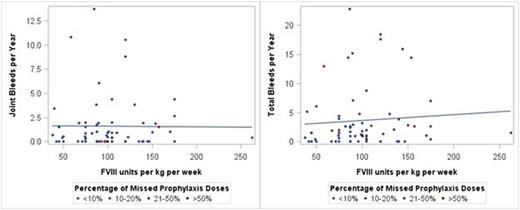Abstract
Background: Patients with severe hemophilia A (factor VIII (FVIII)<1%), as well as many patients with moderate hemophilia A (FVIII 1-5%), are treated intravenously with FVIII prophylaxis to prevent bleeding. However, breakthrough bleeding occurs in many patients.
Methods: To better understand breakthrough bleeding, we evaluated the effect of hemophilia severity, prophylaxis adherence, and replacement FVIII utilization on bleeding rates in patients with hemophilia A on prophylaxis. Data on hemophilia severity and bleeding rates were collected from subjects with hemophilia A, ages 2-30 years, treated at the University of Colorado for hemophilia A, using the University of Colorado Clinical Research Bleeding Disorders Database (UCBDD). Adherence and FVIII utilization data were collected from a subset of subjects with hemophilia A on prophylaxis without active inhibitors who participated in the Centers for Disease Control/American Thrombosis and Hemostasis Network Community Counts (CDCCC) registry between December 2013 and June 2016, which surveyed participants about their estimated percentage of missed prophylaxis doses. The CDCCC registry was also used to corroborate bleeding rates. The effect of hemophilia severity and missed prophylaxis doses (percentage of prescribed doses) on bleeding rates were analyzed using logistic regression, with bleeding rates dichotomized as high or low relative to study population median bleeding rates. The relationship between weekly factor utilization and annualized bleeding rates was evaluated using Pearson's correlation.
Results: Of 89 patients with severe hemophilia A in the UCBDD, 86.5% of patients were on continuous prophylaxis, with an additional 7.9% on immune tolerance induction. The 5.6% of patients with severe hemophilia on episodic treatment had been encouraged to use prophylaxis but had declined. Of 37 patients with moderate hemophilia A, 48.7% were on continuous prophylaxis. Sixty-nine subjects on prophylaxis had data in the UCBDD and the CDCCC registry collected during the defined time period. Bleeding rates are shown in Table 1. Prophylaxis doses in this population had an interquartile range of 74.3 to 120 units/kg/week (mean 96.9 units/kg/week), dosed 2-7 times per week depending on activities and historic bleeding patterns. Eighty-two percent of patients rated their percentage of missed prophylaxis doses at <10%, 11.6% rated their missed doses at 10-20%, 2.9% rated their missed doses at 21-50%, and 2.9% rated missed doses at >50%. There was not a statistically significant relationship between any bleeding rate and percentage of missed doses, hemophilia severity, or factor utilization, as shown graphically in figures 1 and 2.
Conclusion: Although prophylaxis usage and adherence were excellent, breakthrough bleeding was common, with breakthrough joint bleeding occurring in 36% of subjects, and was not related to FVIII dose per week. Prospective studies are needed to better determine individually tailored prophylaxis regimen using dose, product class, and timing with activities, in order to achieve more effective prophylaxis.
Bleeding Rates on Continuous Prophylaxis. No intracranial or gastrointestinal hemorrhages were recorded in this population.
Bleeding Rates on Continuous Prophylaxis. No intracranial or gastrointestinal hemorrhages were recorded in this population.
Relationship between Bleeding Rates, Hemophilia Severity and Adherence
No correlation was found between bleeding rates and factor VIII utilization as measured in units per kg per week.
No correlation was found between bleeding rates and factor VIII utilization as measured in units per kg per week.
Warren:HTRS/Novo Nordisk: Research Funding; Bayer Hemophilia Awards Program: Research Funding. Wang:Biogen: Membership on an entity's Board of Directors or advisory committees; CSL Behring: Membership on an entity's Board of Directors or advisory committees; Baxalta: Membership on an entity's Board of Directors or advisory committees; HEMA Biologics: Membership on an entity's Board of Directors or advisory committees; LFB: Membership on an entity's Board of Directors or advisory committees; Novo Nordisk: Membership on an entity's Board of Directors or advisory committees. Manco-Johnson:Baxalta: Honoraria; NovoNordisk: Honoraria; BiogenIdec: Honoraria; Bayer: Honoraria, Research Funding; CSL Behring: Honoraria.
Author notes
Asterisk with author names denotes non-ASH members.




This feature is available to Subscribers Only
Sign In or Create an Account Close Modal